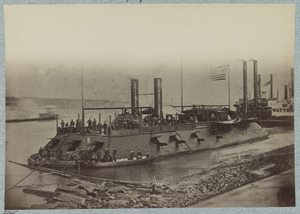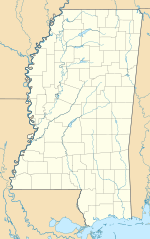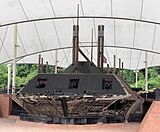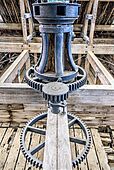USS Cairo facts for kids

USS Cairo at anchor
|
|
Quick facts for kids History |
|
|---|---|
| Name | Cairo |
| Namesake | City of Cairo, Illinois |
| Operator | |
| Ordered | August(?) 1861 |
| Builder | James Eads and Company, Mound City, Illinois |
| Laid down | 1861 |
| Launched | 1861 |
| Commissioned | 25 January 1862 |
| Fate | Transferred to the US Navy |
| Name | Cairo |
| Commissioned | 1 October 1862 |
| Fate | Sunk by mine, 12 December 1862 |
| Status | Raised, 1964, museum ship |
| General characteristics | |
| Class and type | City-class ironclad |
| Tonnage | 512 |
| Length | 175 ft (53.3 m) |
| Beam | 51 ft 2 in (15.6 m) |
| Draft | 6 ft (1.8 m) |
| Installed power | 5 fire-tube boilers |
| Propulsion |
|
| Speed | 4 knots (7.4 km/h; 4.6 mph) |
| Complement | 251 officers and enlisted men |
| Armament | (see section below) |
| Armor |
|
|
USS Cairo
|
|
| Built | 1861 |
| NRHP reference No. | 71000068 |
| Added to NRHP | 3 September 1971 |
The USS Cairo was a special kind of warship called an ironclad. It was built during the American Civil War to patrol rivers. Ironclads were ships covered in thick metal armor, making them very strong against enemy fire.
The Cairo was named after Cairo, Illinois, a city in the United States. In June 1862, it helped capture Fort Pillow, Tennessee on the Mississippi River. This victory allowed Union forces to take over Memphis, Tennessee.
Later that year, the Cairo became famous for a sad reason. On December 12, 1862, it was sunk by a "torpedo," which was an old word for a naval mine. This mine was set off by people hiding on the riverbank. The Cairo was the first ship ever sunk by a mine detonated this way.
Today, you can see the remains of the Cairo at Vicksburg National Military Park. There's also a museum there with its weapons and other items.
Contents
The Cairo's Role in the Civil War
The Cairo was built in 1861 by James Eads and Co. in Mound City, Illinois. It was part of the Union Army's Western Gunboat Flotilla. This group of ships helped the Union control important rivers during the war.
The ship served on the Mississippi River and Ohio River, as well as their smaller branches. In October 1862, the Cairo and other river gunboats were moved to the Union Navy.
Key Battles and Missions
The Cairo was involved in several important events. It helped occupy Clarksville, Tennessee, in February 1862. Soon after, it helped take Nashville, Tennessee.
In April, the Cairo escorted ships carrying large cannons to attack Fort Pillow. After many days of fighting and blockading, the Confederate defenders left the fort in June.
Just two days later, on June 6, 1862, the Cairo joined a big battle near Memphis. Seven Union ships and a tugboat fought against eight Confederate gunboats. The Union side won, sinking or damaging most of the enemy ships. Union forces then took control of Memphis.
The Cairo continued to patrol the Mississippi River. In November, it joined a mission called the Yazoo Pass Expedition.
The Sinking of the Cairo
On December 12, 1862, the Cairo was clearing mines from the river. This was to prepare for an attack on Haines Bluff. Suddenly, the ship hit a naval mine. The mine was set off by volunteers hidden on the riverbank.
The Cairo sank in just 12 minutes. Luckily, no one on board was hurt. This event marked a new kind of naval warfare, as it was the first time a ship was sunk by a remotely detonated mine.
Weapons of the USS Cairo
The weapons on the Cairo changed over time. To get the ship ready for battle quickly, it was first fitted with whatever guns were available. Later, its weapons were updated with newer, better ones.
The ship had some modern 8-inch smoothbore guns. But many of its other original weapons were older. For example, some 42-pounder guns were old smoothbore cannons that had been changed to fire rifled (grooved) bullets. These changed guns were not as strong and could sometimes explode.
The Cairo also carried a 12-pounder howitzer. This smaller gun was used to defend against enemy soldiers trying to board the ship. It was not used for regular combat.
| January 1862 | November 1862 |
* 3 × 8-inch smoothbore cannons
|
* 3 × 8-inch smoothbore cannons
|
Finding the Lost Ship
After it sank, the Cairo was forgotten for many years. It slowly became covered by mud and sand at the bottom of the river. This mud actually helped preserve the ship and its unique historical items. It was like a time capsule!
People weren't sure exactly where the ship was. But Edwin C. Bearss, a historian from Vicksburg National Military Park, decided to look for it. He used old Civil War maps and a simple magnetic compass.
With help from Don Jacks and Warren Grabau, the Cairo was finally found in 1956. In 1960, many items were pulled from the ship. These included the pilothouse (where the ship was steered) and an 8-inch cannon. The Yazoo River mud had kept them in good condition.
With support from the state of Mississippi, the gunboat was eventually brought up from the river bottom.
Saving and Displaying the Cairo
When they tried to lift the Cairo in October 1964, the cables cut into its wooden hull. It became clear they couldn't lift the whole ship in one piece. So, they decided to cut the Cairo into three sections.
By the end of December, the ship's remains were placed on barges. They were then taken to Vicksburg, Mississippi. In 1965, the barges moved to Ingalls Shipyard in Pascagoula, Mississippi. There, the armor was removed and cleaned. The two engines were also taken apart, cleaned, and put back together.
Sections of the hull were supported, and a sprinkler system kept the wood wet. This stopped the white oak timbers from twisting or cracking. On September 3, 1971, the Cairo was added to the National Register of Historic Places. This list recognizes important historical sites.
In 1972, the U.S. Congress allowed the National Park Service to take care of the Cairo. Their plan was to restore it and display it at Vicksburg National Military Park. After some delays, the ship was moved to the park in June 1977. It was partly rebuilt on a concrete base near the Vicksburg National Cemetery.
A shelter was built over the ship in October 1980, and the museum opened in November. The museum now has a new, better shelter.
Treasures from the Deep
Finding the Cairo was like finding a treasure chest! Many items were recovered, including weapons, ammunition, and personal belongings of the sailors. These items give us a glimpse into life on a Civil War gunboat.
You can see the gunboat and all these amazing artifacts at the USS Cairo Museum in Vicksburg. For example, there's a sailor's rope knife that is still in great condition.
Over time, the Cairo has faced damage from weather and other things. But it remains an important piece of history. There are only three other Civil War-era ironclads still existing today: USS Monitor, CSS Neuse, and CSS Muscogee.
Images for kids
- Images of USS Cairo
See also
 In Spanish: USS Cairo (1862) para niños
In Spanish: USS Cairo (1862) para niños
- Anaconda Plan
- Mississippi Squadron
- Union Navy
- List of United States Navy ships







